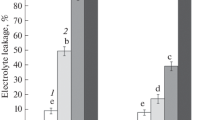Summary
-
1.
Fixation in osmium, dehydration, and embedding of frond cells ofFucus vesiculosus L. proved to be more successful in winter than in summer, possibly because of biochemical changes in the cytoplasm or changes in permeability with the season.
-
2.
There was no apparent change in the ultra-structure of chromoplasts from summer to winter. Six different lamellae, formerly believed to be four, were observable in a packet, and about 13 such packets across the thick part of the chromoplast. Globuli in chromoplasts appeared to consist of two membranes and have optically empty centers.
-
3.
Cytoplasmic vacuoles appeared nearly filled in winter with an electron-dense material, while in summer, vacuoles were not so-filled, and some of the summer vacuoles appeared smaller than in winter.
Similar content being viewed by others
Literature
Anon., 1960: Navy pursues indefinite preservation of blood. Naval Res. Rev., September, p. 21.
Gibbs, Sarah P., 1960: The fine structure ofEuglena gracilis with special reference to the chloroplasts and pyrenoids. J. Ultrastructure Res.4, 127–148.
Grell, K. G., and K. E. Wohlfarth-Bottermann, 1957: Licht und Elektronenmikroskopische Untersuchungen an den DinoflagellatenAmphidinium elegans N. S. P. Z. Zellforsch. mikroskop. Anat.47, 7–17.
Leyon, H., and D. von Wettstein, 1954: Der Chromatophoren-Feinbau bei den Phaeophyceen. Z. Naturforsch.9b, 471–475.
Menke, W., 1960: Das allgemeine Bauprinzip des Lamellarsystems der Chloroplasten. Experimentia16, 537–538.
Parker, J., 1957: Seasonal changes in some chemical and physical properties of living cells ofPinus ponderosa and their relation to cold resistance. Protoplasma48, 147–163.
—, 1960a: Seasonal changes in the physical nature of the bark phloem parenchyma cells ofPinus strobus. Protoplasma52, 223–229.
—, 1960b: Seasonal changes in cold hardiness ofFucus vesiculosus. Biol. Bull.119, 474–478.
—, and D. E. Philpott, 1961: An electron microscopic study of chloroplast condition in summer and winter inPinus strobus. Protoplasma53, 575–583.
Philpott, D. E., 1955: A simple economic microtome for ultra-thin sectioning. Exper. Med. Surg.13 (June).
Salt, R. W., 1961: Principles of insect cold-hardiness. Ann. Rev. Ent.6, 55–74.
Sakai, A., 1961: Effect of polyhydric alcohols on frost-hardiness in plants. Nature189, 416–417.
Sorvall, I., 1959: Thin sectioning and associated technics for electron microscopy. 1. Sorvall Inc., Norwalk, Conn.
Author information
Authors and Affiliations
Rights and permissions
About this article
Cite this article
Parker, J., Philpott, D.E. Cellular ultra-structure ofFucus vesiculosus frond in summer and winter. Protoplasma 57, 628–635 (1963). https://doi.org/10.1007/BF01252081
Received:
Issue Date:
DOI: https://doi.org/10.1007/BF01252081



